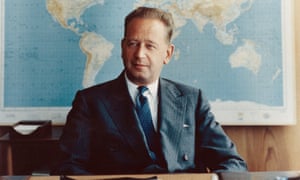The Guardian| Julian Borger World affairs editor Tuesday 26 September 2017 05.41 EDT

The scattered wreckage of the Douglas DC-6 carrying Dag Hammarskjöld in a forest near Ndola, Zambia. Photograph: AP
A UN report into the death of its former secretary general Dag Hammarskjöld in a 1961 plane crash in central Africa has found that there is a “significant amount of evidence” that his flight was brought down by another aircraft.
The report, delivered to the current secretary general, António Guterres, last month, took into account previously undisclosed information provided by the US, UK, Belgian, Canadian and German governments.
Its author, Mohamed Chande Othman, a former Tanzanian chief justice, found that the US and UK governments had intercepted radio traffic in the area at the time and suggested that the 56-year-old mystery could be solved if the contents of those classified recordings were produced.
“I am indebted for the assistance that I received, which uncovered a large amount of valuable new information,” Othman said in an executive summary of his report, seen by the Guardian. “I can confidently state that the deeper we have gone into the searches, the more relevant information has been found.”

Dag Hammarskjöld was on a mission to try to broker peace in Congo when he died in 1961. Photograph: REX
Hammarskjöld, a Swedish diplomat who became the UN secretary general in 1953, was on a mission in September 1961 to try to broker peace in Congo, where the Katanga region had staged a rebellion, backed by mining interests and European mercenaries, against the newly independent government in Kinshasa.
His plane, a Douglas DC-6, was on the way from Kinshasa to the town of Ndola in Northern Rhodesia (now Zambia), where the British colonial authorities were due to host talks with the Katanga rebels. It was approaching the airstrip at about midnight on 17 September when it crashed, killing Hammarskjöld and 15 others on board.
Two inquiries run by the British pointed to pilot error as the cause, while a UN commission in 1962 reached an open verdict. In recent years, independent research by Göran Björkdahl, a Swedish aid worker, and Susan Williams, a senior fellow at the Institute of Commonwealth Studies in London and author of a 2011 book Who Killed Hammarskjöld?, persuaded the UN to reopen the case. A panel convened in 2015 found there was enough new material to warrant the appointment of an “eminent person” to assess it. Othman was given the job in February this year.
Among Othman’s new findings are:
- In February 1961, the French secretly supplied three Fouga warplanes to the Katanga rebels, “against the objections of the US government”. Contrary to previous findings, they were used in air-to-air attacks, flown at night and from unpaved airstrips in Katanga.
- Fresh evidence bolsters an account by a French diplomat, Claude de Kemoularia, that he had been told in 1967 by a Belgian pilot known as Beukels, who had been flying for the rebels as a mercenary, that he had fired warning shots to try to divert the plane away from Ndola and accidentally clipped its wing. Othman said he was unable establish Beukels’ identity in the time available for his inquiry.
- The UK and Rhodesian authorities were intercepting UN communications at the time of the crash and had intelligence operatives in the area. The UK should therefore have potentially crucial evidence in its classified archives
- The US had sophisticated electronic surveillance aircraft “in and around Ndola” as well as spies, and defence officials, on the night of the crash, and Washington should be able to provide more detailed information.
Othman found that earlier inquiries had disregarded the testimony of local witnesses who said they saw another plane and flashes in the sky on the night of Hammarskjold’s crash. They had also “undervalued” the testimony of Harold Julien, a security officer who survived for several days who told medical staff he had seen “sparks in the sky” shortly before the DC-6, known by its registration number SE-BDY, fell out of the sky.
“Based on the totality of the information we have at hand, it appears plausible that external attack or threat may have been a cause of the crash, whether by way of direct attack causing SE-BDY to crash, or by causing a momentary distraction of the pilots,” Othman concludes.
“There is a significant amount of evidence from eyewitnesses that they observed more than one aircraft in the air, that the other aircraft may have been a jet, that SE-BDY was on fire before it crashed, and/or that SE-BDY was fired upon or otherwise actively engaged by another aircraft. In its totality, this evidence is not easily dismissed.”
Othman argues that the “burden of proof” was now on member states “to show that they have conducted a full review of records and archives in their custody or possession, including those that remain classified, for potentially relevant information”.
The Tanzanian judge said that the most relevant pieces of information were radio intercepts and called for countries likely to have relevant information, such as the UK and US, to appoint an “independent and high-ranking official” to comb the archives.
CONTINUE READING AT THE GUARDIAN
Related: United Nations: Death of Dag Hammarskjöld, 18 September 1961, 1961: 18 September-28 October
Related: Do Spy Agencies Hold Answer to Dag Hammarskjold’s Death? U.N. Wants to Know
Related: UN chief: Tanzanian to lead Hammarskjold air crash review
Related: Book Review: Spies in the Congo by Susan Williams
Related: U.N. Chief Presses to Unlock Mystery of Dag Hammarskjold’s Death
Related: The Hammarskjöld Commission – Witness Statement of Lisa Pease
Related: The Mysterious Death of a UN Hero




